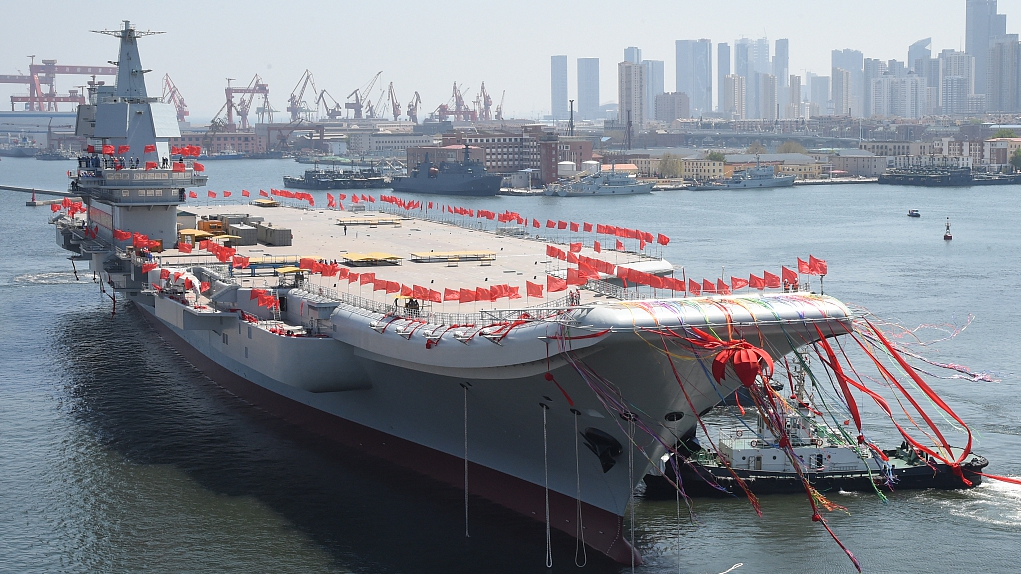
Pic Courtesy: Internet
Over the next couple of years, the People’s Liberation Army Navy (PLAN) will undertake intensive trials of its third aircraft carrier, the Fujian (Type-003), to bring it into service. China has been intent on building its carrier capacity since the 1970s. The last five decades have been a journey of discovery and determination for a country with no previous experience.
The Chinese effort accelerated in the 1980s under Liu Huaqing, commander-in-chief of the navy, who subsequently served on the Central Military Commission. He is widely credited as the father of the modern Chinese navy and its carrier capability.
First Step. Beijing’s early moves were surreptitious and creative. China closely studied the decommissioned Australian aircraft carrier HMAS Melbourne, sold for scrap to a Chinese company in 1985 with a surprising amount of its aircraft-operating equipment – catapults, arresting gear, mirror landing sights and flight deck arrangements – left intact. The ship was not dismantled for many years after it arrived in China.
First Carrier with Soviet Role. In the 1990s, China gambled on the purchased ex-Soviet hybrid carriers Kiev and Minsk and the incomplete hull of the larger Varyag (which would have been a sister ship to the Soviet and then Russian navy’s Admiral Kuznetsov), supposedly to turn them into floating hotels or casinos. China reportedly also bought eight truckloads of detailed design drawings of the ship. While two of them, after extensive evaluation, took on their civilian role, the ex-Varyag was completed in China as the PLAN’s prototype carrier Liaoning.
Gaining Experience. The effort allowed the PLAN to gain rapid early experience in carrier operations at sea (ship handling and maintenance skills), carrier air operations and integration into a task-group formation. Chinese planners carefully studied the practices of other navies (particularly those of the US Navy). Two months after the PLAN commissioned the Liaoning, it carried out the first landing and take-off of a J-15 fighter at sea. The PLAN also adapted US flight-deck procedures and organisations, including colour-coding uniforms to denote the role of personnel.
Carrier Capability Development. Beijing declared the Liaoning ‘combat ready’ in November 2016 and an initial operating capability for the carrier and its task group in May 2018. China’s second carrier, the Shandong, a domestically built improved version, was commissioned in December 2019 and supposedly achieved initial operating capability the following year. Given its challenges, the PLAN’s development of carrier capabilities was relatively cautious, and the operational capability remains limited. The carriers only recently have embarked on more extended deployments further from Chinese home waters.
Carrier Air Operations: Teething Problems. The PLAN’s carrier fighter, the J-15 is an unlicensed development of the Russian Su-33. It has shortcomings due to its size, weight and operational characteristics. Carrier-capable fighters are in relatively short supply and barely sufficient for two carrier air groups. The size and design of the existing carriers, especially the lack of a catapult launching system, significantly constrain aircraft range and payload. More complex operational flying at sea, including night-time operations, remains a work in progress. Pilot training is another area of concern.
Fujian (Type-003). The arrival of the Fujian addresses some of the earlier issues. The ship represents a significant advance on the navy’s first two carriers, the Liaoning and Shandong. The indigenous design is larger than its predecessors and equipped with an electromagnetic catapult launch system rather than a ‘ski ramp’ for aircraft launches, enabling a larger and more capable air group. While that requires a step change in the PLAN’s capacity to support the operation of such a vessel, it will bring the PLAN closer to its ambition for a fully capable carrier force.
Carrier Air Operations: Work in Progress. Fujian is expected to introduce electromagnetic catapult system technology. Operationalisation of the system has its challenges. While upgrading the J-15 aircraft, China is developing a carrier-compatible variant of the J-35 aircraft, a variant of the J-31. At least three prototypes of the twin-engine J-35 are undergoing flight testing. Along with the J-35, the PLAN is supporting the development of the KJ-600 airborne early warning platform for carrier operations, with several airframes under consideration.
Future Trajectory. The PLAN’s experience of fielding the Fujian will influence the further development of its carrier force. PLAN appears intent on having a force of at least six carriers sometimes (maybe by the 2030s). While a fully-fledged carrier force may still be some way off, with a decade of experience in carrier operations, the PLAN appears to have mastered a limited degree of power projection capability. Future ships may be larger with nuclear propulsion.
Suggestions and value additions are most welcome
For regular updates, please register here:-
References and credits
To all the online sites and channels.
The International Institute for Strategic studies, “The Military Balance 2024”.
Disclaimer:
Information and data included in the blog are for educational & non-commercial purposes only and have been carefully adapted, excerpted, or edited from sources deemed reliable and accurate. All copyrighted material belongs to respective owners and is provided only for purposes of wider dissemination.
